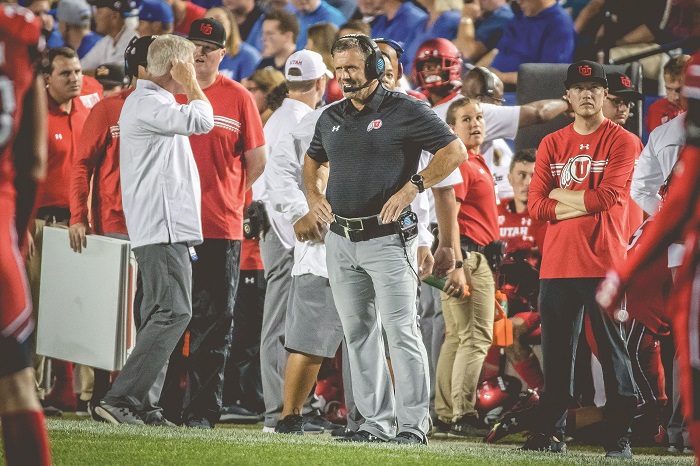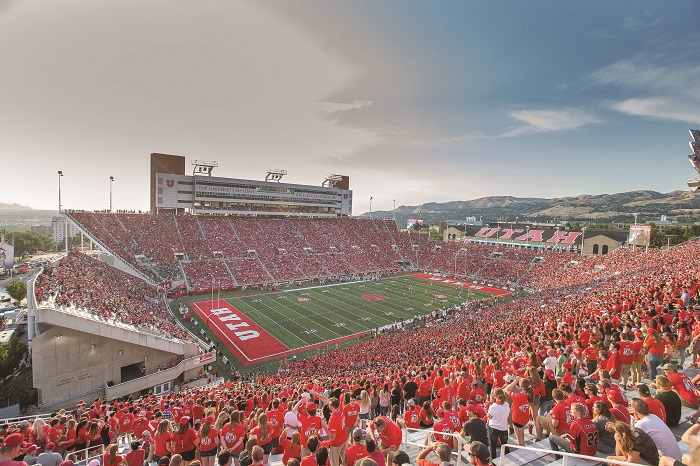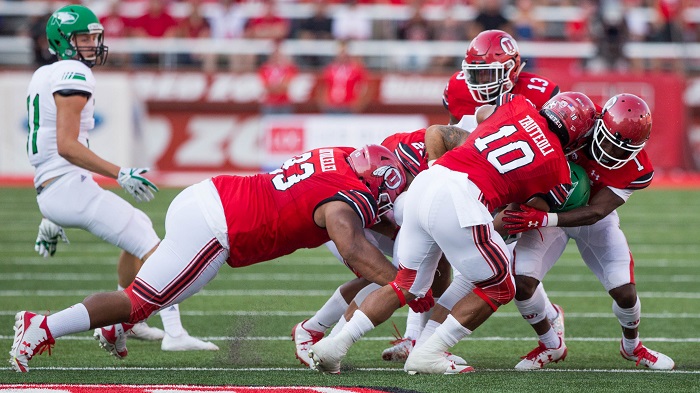
Enter the Spencer Eccles Fox University of Utah football facility—shiny marble floors, high ceilings with the finest museum-quality lighting; shiny chrome football statues adorn the lobby. Photos, videos, pendants, and mementos are on display, showcasing a truly significant program. The “wow factor” is unmatched anywhere on the entire University of Utah Campus.
But this is actually nothing special for a PAC 12 school. “You should see Oregon’s football locker room and facilities,” Dirk Facer, 20-year reporter for the Deseret News, tells me. “Phil Knight of Nike has donated millions to that program.” ($68 million alone to Oregon’s “Football Performance Center”.)
Still, I’m stunned walking in, because the comparison to the facility where our Nobel Laureate biochemist, Mario Capecchi does his work, is starkly different. Not that science needs a lot of shiny walls and floors, but it’s clear that not only football training and passion live here, but also that huge sums of cash have been pumped into this program.
I’ve come to realize that this facility isn’t so much a reflection of skewed priorities (as I thought when I was attending the U of U), but is due to college football’s incredible popularity. Ask any football fan what they enjoy watching more—NFL or college football—and many will now say college, due to the absence of politics and huge egos. Rice-Eccles regularly fetches over $93 for the cheap seats. The MUSS is famous for their noise factor. ESPN knows this campus well. I suppose “We Utes” have arrived.
This is where the best of the best young football talent is nurtured. It’s where kids either sink or swim. Those who swim with the right physique and natural-born talent and great coaching go on to the NFL. “You may have one year, two years, or you might have a really extended career and play ten years,” according to head football coach, Kyle Whittingham.
Whittingham doesn’t offer any delusions: an NFL career, if it happens at all, is usually very short. Still, most contracts are for millions of dollars. But coach Whittingham keeps the student-athletes grounded. Whittingham says, “At some point as a football player, your lifespan is over, and that’s usually around 30-years-old, football wise. And you have about 35 years more where you have to find something to do and something to contribute to society, so our guys understand that and they are all working on degrees.”
For my first tour of the facility, I came with the Holladay Chamber of Commerce. We were treated to a 30-minute speech and Q&A session by Coach Whittingham. I came because I wanted to see what special qualities the highest paid employee in the state of Utah might possess to justify his $3.3 million-dollar annual salary.
I wasn’t expecting to be impressed, and I must admit I’m a little jaded by how football dominates the entire college experience. But I’ve been enjoying the Utes in recent years because they play with such an excellent execution. Their players are athletic and fun to watch. They seem to be driven not just to succeed, but to excel both on and off the field.
Whittingham explains that “This year’s theme is understanding the ‘why’ behind football. I’m challenging each player to ask himself why he is here, why he is putting all of this work and effort in showing up to practice and working hard each day.”
 Whittingham explains that by defining their personal purpose for being in the football program, the students will also take their academics and the entire opportunity more seriously. He gleaned this information from a leadership book written by Simon Sinek, “Start with Why”, which offers advice to CEOs for nurturing talent. Whittingham’s strategies seem to be working.
Whittingham explains that by defining their personal purpose for being in the football program, the students will also take their academics and the entire opportunity more seriously. He gleaned this information from a leadership book written by Simon Sinek, “Start with Why”, which offers advice to CEOs for nurturing talent. Whittingham’s strategies seem to be working.
Last year, eight University of Utah football scholarship graduates were invited to come to training camps of NFL teams. All eight were drafted and seven were awarded free-agent contracts. The average contract value was around $3.5 million over four years. “But not,” Whittingham explains, “because the largest number of athletes signed contracts, but that every senior on the team graduated with a degree.”
I made an attempt to sit down with Whittingham for an interview but was told he was too busy, so I decided to visit a practice with other media and question some of the players to see what they have to say.
I was surprised to find about ten other media folks there as well. The Salt Lake Tribune had three reporters and a photographer. The big story, despite the first two wins of the season, was the unforced errors from the first two games. Simple hand-offs were being dropped. Snaps fumbled. Most of the players on this year’s team are extremely young. But there were a few exceptions which made the difference for the Utes in winning their first three battles.
Wide receiver Darren Carrington Jr. was kicked out of Oregon’s top ranked program for doing, let’s just say—a lot of bad stuff. He was getting into trouble for drugs and DUIs and fights, and off the field he was hanging out with the wrong crowd. But the Ducks understand that a lot of their players are living the “thug life” and they allow them a long leash. Perhaps too long for Carrington.
Carrington is thriving with the Utes. While the other extremely young players are trying to learn the offense, proper snap, hand off, pass, and gel together, Carrington’s catching and running abilities are outstanding on an entirely different level. In his first game he caught ten passes and had 127 yards, leading the Utes to a victory over North Dakota.
He scored two touchdowns against BYU and two against San Jose State, one in which he bent down to catch an extremely low pass. He managed to pivot sideways and leap with the ball, crossing the threshold of the goal line. Carrington’s physique is tall and lean. Veins bulge in his legs. He looks like a NFL candidate. His father played eight years in the NFL, mostly for the San Diego Chargers. Junior could have chosen a number of top schools, but thought Utah was a place he could stay focused and out of trouble. He was right.
“I’m enjoying myself out here. It’s a lot more like when I was in high school and I was playing just for fun and I’m really enjoying my teammates,” Carrington told Utah Stories.
His comments were made with a smile by a guy with tight dreadlocks of yellowish hair, who appeared perfectly in his element. “I’ve really made a lot of friends here. Less like teammates and more like brothers, and that’s really cool to have here. Everything Coach Taylor says to me is positive. Even if it’s negative, I take it and move on. I just go out there and make plays. [It’s great] to have coaches that are so happy and confident in me. I just play. Back here I feel like I got my mojo back,” Carrington says.
But with the ability to choose any place, why Utah?
“My parents really like how real and genuine coach Whitt was, and how his son is playing here. I don’t blame anything on Taggert. I still love that dude, most definitely, but I believe this is the place that God was calling me to,” said Carrington.
Of course they aren’t paid, but coach Whittingham believes they should be. I asked him about this and he said, “Yea, I would. The guys that we have in this program—we aren’t a bunch of choirboys. We have guys that come from some really hard situations, and they don’t have a dime coming in from back home, not a dime. And the NCAA limitations they have put on them, they can hardly function other than to just basically eat and go to school. If we put a few more dollars in their pocket, there are millions of dollars being generated, millions and millions. So why not give them a little more so that they aren’t scraping by and just barely making ends meet anymore?”
Whittingham is in the minority opinion. I asked other sports reporters and athletic assistants and they all believed there was too much money and gifts given to the kids, and that money would be an added distraction. But Coach Whitt has always been a player’s coach. He will do anything to help out the guys on the team.
Touring the facility, I get a peek into the lives of the student athletes. Their locker room amenities could rival any professional team. The equipment room is full of the finest Under Armor products of all sizes: gloves, practice shirts, socks, Nike shoes in several styles and sizes—anything and everything they might need, and all totally free.
Their cafeteria offers an all-you-can-eat buffet, open all day, every day. Made-to-order burgers, grilled salmon with rice pilaf, pizzas of all varieties, and a massive salad bar and desserts. The offices for every coach include a theater for every player at every position, where they can review and analyze their own performance as well as prepare for the upcoming teams, review the match-up, and determine tactics.
Whittingham explains that the new facility has been an excellent recruiting tool. And by recruiting better players, they are graduating more players every year, and more are being drafted into the NFL.
Whittingham attributes much of his success to his great friend and mentor, former BYU coach LaVell Edwards. “Coach Edwards instilled in me the ethic that ‘You do what you believe in, do it the way that you believe it should be done, and stick to it. And if you have some rough spots, don’t panic; don’t deviate from the plan, just work through it.’”
He says his dedication to the players was a result of LaVell driving this theme home to them when he was at BYU, and the idea that priorities should be family, school and football, in that order.
A bit of irony that the reason BYU has lost to Utah for the past eight seasons is because when Coach Edwards was preparing the next generation of champions, the next great Utah coach was listening.






